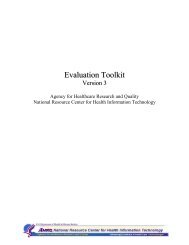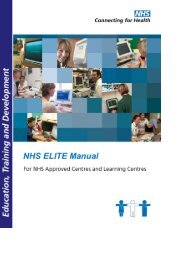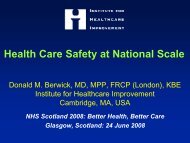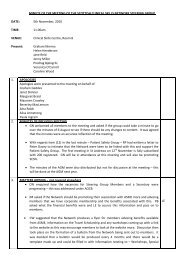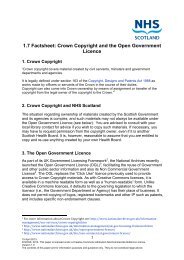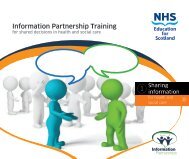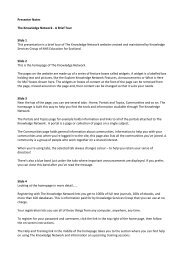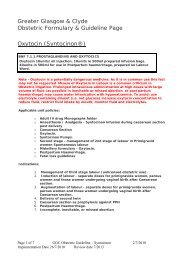The Fife Dementia Strategy: 2010 â 2020 - The Knowledge Network
The Fife Dementia Strategy: 2010 â 2020 - The Knowledge Network
The Fife Dementia Strategy: 2010 â 2020 - The Knowledge Network
You also want an ePaper? Increase the reach of your titles
YUMPU automatically turns print PDFs into web optimized ePapers that Google loves.
Following a diagnosis of dementia, individuals continue to receive high quality<br />
care and services guided by the development of a dementia patient pathway<br />
(see Section 4.2.1).<br />
I remember [my GP] being very very compassionate. He was very good<br />
that way, you know. And he explained the dementia, what effects it would<br />
have on me, you know. And he did say, “If ever you want to come and talk<br />
to me” you know, he was very good, “we’ll have a chat anytime you want<br />
to come.” (Person recently diagnosed with dementia)<br />
4.1.2 Develop the role of generalist and non-dementia specialist<br />
clinicians by ensuring clinical staff in primary and secondary care<br />
settings are able to recognise a potential case of dementia, rule out<br />
alternate explanations, and make an appropriate referral to specialist<br />
services for further assessment.<br />
Local consultations completed within <strong>Fife</strong> show that it is generally the case<br />
that primary care and non-specialist 14 physicians do not make a diagnosis of<br />
dementia; rather if they recognise potential cases of dementia they will refer<br />
their patient on to the appropriate specialist service. This practice is<br />
concordant with the rest of the UK 15 . Non-specialist clinicians in secondary<br />
and acute care services play a similar role in this regard and face similar<br />
challenges in accessing specialist services and equipment necessary to make<br />
a dementia diagnosis.<br />
<strong>The</strong>re is a local concern that general awareness and recognition of dementia,<br />
as well as understanding of what to do if a patient is suspected of having a<br />
dementia in non-dementia/older person specialists, is limited. And, despite<br />
improvements being made in recognition, referral and diagnosis, the culture<br />
continues to be one of under diagnosis. Thus, as highlighted in Sections 3<br />
and detailed in the Implementation Plan, an educational and awareness<br />
raising programme targeted at generalist/non-specialist clinicians will be<br />
developed. <strong>The</strong> targeted programme will be in line with SIGN guidelines 16 to<br />
reinforce the importance in recognising dementia, making and effectively<br />
communicating an early diagnosis of dementia, developing skills in history<br />
taking for suspected dementia, and also ensuring awareness of follow-on<br />
services available for diagnosis and post-diagnosis support. This work will be<br />
completed in conjunction with the development of a clear referral pathway for<br />
assessment and investigation (4.1.1), and a continuing patient pathway<br />
(4.2.1).<br />
<strong>The</strong> education programmes highlighted in Section 3 will lead to increases in<br />
the number of people with suspected dementia being referred to specialist<br />
services for assessments. As the SIGN dementia guidelines should be<br />
14 <strong>The</strong> term ‘non-specialist physicians’ refers to all physicians who would not normally make a<br />
differential diagnosis of dementia.<br />
15 DOH (2009) National <strong>Dementia</strong> <strong>Strategy</strong>: Living Well with <strong>Dementia</strong>. Pp 36.<br />
16 SIGN (2006).<br />
26




